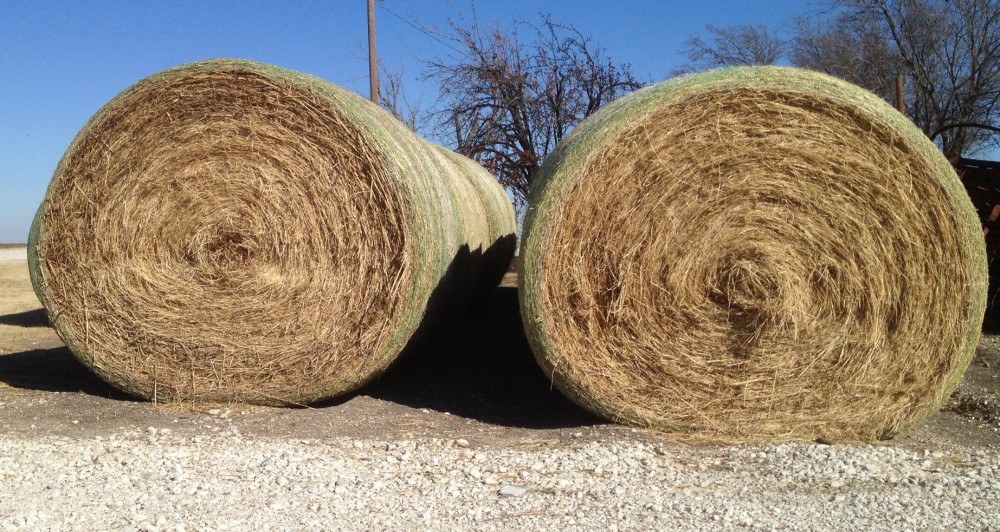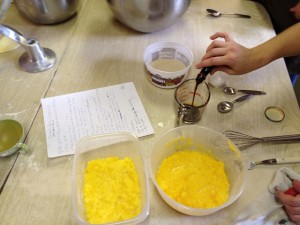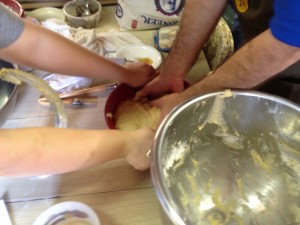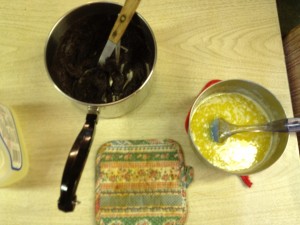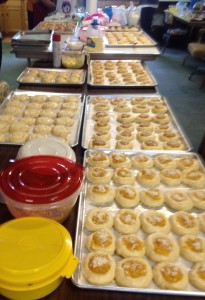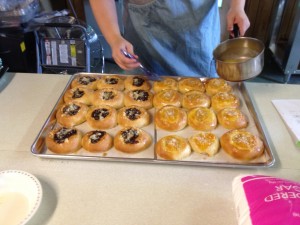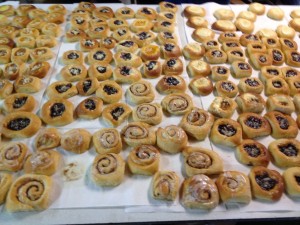In the newest Uncle Joe story, which is reprinted at the end of this introduction, we meet Var an interstellar expeditioner. Curiously, Var is the name of the Norse goddess of contracts, which you might imagine would be a worthy patron for a space trader making a living by barter. At one point, Var mentions to Joe that his many-times great-great grandfather was a Viking and the first of his relatives to sail to the stars.
Curiously, the word “viking” derives from the Old Norse noun “vik,” meaning “creek, inlet or small bay.” We see there, in the root of the word, that the original Vikings lived near the water, in close proximity to the sea. The fact that “vik” is a feminine noun also lets us know that the water was a nurturing motherly figure to those early sea-side settlers, a provider and a place for adventure, not something to be feared, but someone to be enjoyed and returned to. . . .
Adding the active “ing” ending to “vik,” we form the word “viking” to mean the activity of sailing away from home across the open waters. A viking is an “overseas expedition.” The Old Norse masculine noun “vikingr” refers to a seaman or warrior who takes part in such an overseas expedition. A vikingr, or in today’s parlance a Viking (we’ve dropped the “r”), is one who “goes on a viking,” an expedition across the broad waters That’s what Vikings did. They made overseas trips to visit far lands for trade and barter.
The Viking Age extended from around 700 AD to 1100 AD. It was the Dark Ages, the middle of the Middle Ages for much of Europe. The going was not easy, and the times were very dangerous.
The Viking travelers constructed two types of vessels to traverse those turbulent times. The “longship” was for warfare and exploration, it had speed and agility, and it was equipped with a full complement of oars as well as sails. The “knarr” was a merchant vessel, it was designed to carry cargo, and it had just a few oars for maneuvering. Both boats were built with shallow-draft hulls to allow for navigation both across the rough waters of the North and Baltic seas and for upland voyages along rivers and streams to inland towns and villages.
The Vikings had a peculiar style of reading and writing using a unique “runor” alphabet. The majority of runic inscriptions are found in Sweden, which reveals a Scandinavian origin for our Viking sailors. Graves tell their stories as well. The most numerous Viking burial sites with their runic letterings rest in Sweden, Norway, Denmark and northern Germany. It was from these Norse and Scandinavian lands that the Viking of old set sail.
And, they traveled far.
Vikings traded and bartered across Europe and Russia to northern Africa and the Middle East. They visited the Byzantines in Constantinople and the Arabic Peoples in Jerusalem. Across the cold Atlantic, Vikings sailed and reached Iceland, Greenland and North America.
The legacy of the Viking traders remains in much of our world. In some ways, Vikings may be said to be with us even today.
Uncle Joe discovers just how true this might be in the story below.
© James J. Doyle, Jr. 2013
“Over by the new transmission towers, Uncle Joe, that’s where I saw the lights.” Lance shifted his tall teenage frame and waved toward the power lines arching away above the newly plowed fields.
“What time of night did you see ‘em?” Joe asked.
“On the way home from football practice. Shootin’ lights. Flashing.”
“Colors?”
“Kinda’ reds and yellows. They’d turn, and then a purple and orange. Blinking, up and down. And then racing off in streaks.”
“What did you think it was?” Uncle Joe’s hands worked the over-sized steering wheel of the eighteen wheeler. He glanced into the rearview mirror to check the module of cotton they were hauling.
“Dunno.” Lance followed his uncle’s gaze. “Joe, why are we driving the cotton instead of the driver?”
“Stripper was choking up. Driver’s a better mechanic. He’ll get equipment working and we’ll haul the cotton.”
“But, Aunt Suzy owns the gin. The driver works for her.”
“You leave Aunt Suzy to me.”
“You know I will. She’s still mad at me for the window I broke. It was just a football. I didn’t mean to throw the ball like that.”
Joe shook his head with a smile. “Hold on. I’m takin’ a short cut.” Manhandling the wheel, Uncle Joe steered the rig onto the rough gravel of the side road. “We’ll save fifteen minutes.”
“Hardly been this way much. When I was a kid, we’d come down to fish in Birome Creek. Overgrown since then. Looks kinda’ spooky with the shadows this late in the day. I hear no one lives around here anymore.”
“I thought so, too.” Uncle Joe slowed the truck, shifting the gears to a stop.
“What ya’ stopping for . . . ?” Lance stared out the passenger window. “Huh?”
“You can say that again.”
“What is it, Joe?”
“Looks like someone’s house, but I’ve never seen a house like that before.
“It looks like. . . .” Lance began.
“A castle,” his uncle finished.
“Yeah. Old bricks, big bricks. Those towers.” Lance pointed. “I guess you’d call ‘em towers, there at the ends of the walls. And, along the top, with the gaps between the stones? Do you call those . . . battlements?”
“You got it. Battlements. Walls, towers, a fortification. I’d say it’s definitely a castle. Complete with a drawbridge . . . that’s down.” Uncle Joe switched off the diesel engine. “I could use a stretch.” Opening the door, Joe climbed to the ground. “You coming?”
* * *
“No moat?” Joe commented.
Lance stomped on the heavy planking of the lowered drawbridge and stretched over the side. “And no water. Why they need a bridge?”
“Don’t know.” Uncle Joe’s eyes followed the line of the wall. “And why all the smashed vegetation?”
“Kinda’ strange. Like something landed here and pushed the plants down.” Lance squinted up to the battlements. “You think anyone’s at home?”
“Let’s see.” Joe took a few steps, lifted his hand and knocked. “Metal, not wood. No handle. Strange.”
WHOOSH!
Lance jumped as the wall dissolved, revealing an opening about nine-feet wide and nine-feet high.
“Wow, Joe.” The youth moved forward and pointed up toward the lintel. “This is a big door. Must be some tall folks that live here.”
“And, I guess they’re inviting us in.” Uncle Joe stepped over the threshold.
With a long stride, Lance stood inside the structure, swiveling his head back toward the truck.
WHOOSH!
The youth jerked upright and reached to touch cold metal where the opening had been. “How’d it do that?”
“Umgib oa chot, tweeze. Tweeze.”
They both froze and slowly turned.
At the end of an arched tunnel about forty feet long, a figure sat behind a desk. A soft electric glow emanated from the walls. On the desk, an oil lamp flickered, the flashes of light reflected off the metal cap of a black-bearded fellow dipping a stylus into a jar of ink.
“Uk, Uk,” the seated figure coughed impatiently.
Uncle Joe shrugged and started walking toward the man. Lance followed a half-step back. Joe stopped in front of the desk, smiled and waited.
A large hand placed the writing instrument in the ink well. The hairy forearm disappeared at the elbow into a heavy, dark-brown, furred jacket held together across the broad chest with wooden togs through leather loops. Snorting, the full-bearded scribe turned to his right and laughed, “Enz up bit ’tis.” A tall figure in the shadowed alcove laughed back and rattled a long sword in one hand against the wooden shield held in the other fist.
Uncle Joe laid a calming hand on Lance but said nothing.
The scribe leaned back in his seat and addressed Joe. “Matter embeing tamp te cawottong, Achhae Dat?”
Tapping an index finger to his ear, Uncle Joe shook his head back and forth. Then he tapped his lips with the same finger and moved his head up and down.
The actions brought a look of appreciation to the bearded face. Reaching into a pocket, the seated figure extracted several small objects and handed them across.
Uncle Joe took the oval-shaped devices and passed two to Lance. “Put these in your ears.” Lance watched and did the same.
“What ya’ got to trade, Barbarous One?” The seated figure laughed as he slapped two big hands on the ledger in front of him.
“What do you have to trade to me, my bearded friend?” Joe smiled as he answered.
The scribe chuckled and turned to the nook. “I knew this spot had potential. Toss me the goods.” His companion leaned the shield against the side-wall of the recess, reached into his woolen jacket above the long leather-clad legs, extracted a packet and tossed it to the seated figure who caught it neatly in mid-air. Loosening the drawstring, the trader dumped the contents onto the desktop where the cut stones sparkled and refracted the light in rainbows against the walls. He motioned with his hands for Joe to examine the rocks.
“Are they what I think they are?” Lance asked as Uncle Joe picked up a stone, tapped it and held it to the light.
“My guess is diamonds. Two to four carats, each.”
“Your guess is correct, tall stranger. They are diamonds like nobody here ever saw diamonds. But. . . .” The speaker hesitated and lifted an eyebrow in thought before proceeding. “Still, diamonds that will pass all your tests, even though they come from a far-away place.” He stared at Uncle Joe. “Now, what have you to exchange?”
“What are you looking for?”
“That depends. We’re flexible. We usually start with what you have on. The external coverings of your kind have tremendous popularity in some markets.”
“Our work shirts? Jeans?”
“Close, but we go somewhat deeper. The dermal sheathing of the body. You know, your outer layer, your skin.” The accountant pointed to Lance. “Now, this young man would make an excellent donor. Tall, with what is likely a relatively unblemished coat. The process doesn’t hurt. There are the snipping and cutting sounds, but the pulling and stretching is over in a matter of minutes. We install a replacement cover, which is reported to work well in most temperatures. It looks almost like the real thing. Of course, with the distances involved, there is no warranty of fitness for a particular use.”
“Joe, NO!”
Uncle Joe moved his hand to silence Lance. “How much for his skin?” Joe asked.
“JOE!” Lance’s eyes opened wide in terror.
“How much?” Uncle Joe repeated.
“That’s good, very good.” A wide grin crossed the trader’s face. “I almost believe you.” The bearded man stood — to a surprising height, walked around the table and faced Joe. “It was a joke. Not a good one, but it can be an effective trading technique. The other side usually falls to their knees, grovels and offers me anything to keep their skins, or the skins of their friends.” The tall man slowly raised a hand and rubbed his bearded chin. “This could be fun. What do you have to trade? I assure you the diamonds are real.” He touched Joe’s elbow. “Let’s step outside and talk. Perhaps you have something to barter, in addition to your young friend here.”
* * *
“What is this stuff?” The tall bargainer bent and pulled a tuft from the module.
“Cotton,” Joe answered. “You weave the fibers into fabrics for clothing and other uses as coverings.”
“Hammer-Hands, what say you?”
The guard sheathed the long sword and stepped out from behind Joe. Reaching a hand, the associate grabbed a handful of white fluff, rolled the raw fibers between his fingers, grunted and spoke a word under his breath to the scribe.
“I thought as much. It can be used for dermal coverings. There is a real market for something like this, especially on sunny planets with light-skinned residents and their rough clothing. It is amazing how poorly dressed some worlds are and how hungry they are for fashion. With a little marketing. . . .” He nodded to himself in thought. “We’ll take the whole lot for . . . half the diamonds in the bag. What say you?”
“How much are half the diamonds worth?”
“Let’s see, my grand folks stopped by about a hundred years ago. I did a quick survey of your media feeds on the way in, to update our records. I can’t say exactly, but at least two million dollars in the current currency of this country. Could be more. Not going to be less.”
“Joe.” Lance pulled the sleeve of his uncle’s shirt. “That’s a lot of money for one module of cotton.”
“Many times its worth.” A worried look formed at the corners of Uncle Joe’s mouth. “What’s the catch, space trader? Are you really after our skins?”
“Thank you, tall stranger. You make me proud of what I suspect are shared bloodlines.”
“What does that mean?”
“My great grandfather some 37 generations back was a Viking on this planet.”
“37 generations ago?” Joe interrupted, amazement in his voice. “What year was that?”
“That is an interesting question. I have done the research. Geneology is something of a hobby with me. The year was 1079 AD in your local numbering system.”
“Over 900 years ago?”
“Very good. The exact number is 934 years ago.” The scribe paused. “May I continue?” Joe waved the trader forward. “Thank you. As I was saying, Great Grandfather was a Viking and a very successful trader. He hailed from the Baltic, as I suspect your ancestors do also. I take note that the two of you both have blue eyes. Well, that first expeditioner set the style of our operations. He was the one who designed the Viking-class interstellar trading vessel. This is a newer model, but on the outside it’s not much changed. It’s hard to improve on a classic design. In addition to being a talented accountant and a shrewd contract negotiator, Gramps was a marvelous engineer. What a guy. The universe had not seen his like. It was largely because of dear old Great Grandpa that your planet became a regular trading location and stop-by for recruits.”
“Recruits?”
“That’s why I’m offering so much. It’s part for the cotton and part for one of you.”
Uncle Joe’s eyes narrowed as his posture stiffened. Behind Joe, the alcove-guard drew his sword and stood at ready.
“Please, stay calm,” the scribe urged. “Let me explain.”
“Please do.” Uncle Joe’s tone was tight and threatening.”
“Delightful.” The trader smiled. “Truly, you are a joy to observe. I think you would take on Hammer-Hands and his drawn blade. But, there is no need.”
“And why is that?”
“We replicate. Did you think us barbarians?”
Joe moved slightly to present his side to Hammer-Hand’s sword.
“Sometimes actions do speak louder than words.” Admiration was clear in the bargainer’s voice. “One of you, and you may decide which, will be replicated.” The words of the bearded scribe slowed. “Think of it as . . . flash-cloning. Your era is familiar with cloning. When it’s over, there will be two copies of the person. One to go and one to remain.” Uncle Joe edged a foot toward the swordsman. The trader hurried his voice. “Our genetic line is diminished. Births are few. This recruiting is necessary, and it has gone on for centuries. I think your media refers to it as UFO sightings and Encounters of the Third Kind.”
“I think the word is ‘abduction.’” Uncle Joe’s voice was icy.
“No, not at all. One is always returned.”
“Which one?”
“That’s your choice, my friend. The process will be open. When it’s over, the one not replicated may choose. It is not often done this way, but I will do it, to make the trade . . . and avoid any conflict.”
“Who will be replicated?” Uncle Joe did not turn to the speaker.
“Also your choice. You decide.”
Uncle Joe glanced at Lance and said to the trader. “You can replicate me.”
“No, Uncle Joe,” Lance interrupted. “I don’t want to pick one of you. I trust you more than me. With you watching, I’ll do it.”
“And, if you choose rightly, Uncle Joe, if I may call you that, the other half of the diamonds is yours to keep too.”
* * *
“As you see, Uncle Joe, the equipment is quite simple in appearance. Here, your nephew. . . .” The trader paused. “He is your nephew, isn’t he? I see from your nod that he is family. Here, your nephew will rest on this raised platform. The platform will slowly slide through this circular opening. On the other side, only the platform will emerge. The body has moved to processing. Next, we will turn to these two beds and watch as the overhead projector replicates the subject into the two copies.”
“Two copies?” Joe frowned. “I thought one was the original and the other the replicate?”
“Quite so. One will be the original and one the copy. Our quality control experts have done the studies. They say the copy is usually somewhat faster in mental processing and cognitive assembly. That’s the potential upside. In other ways . . . well . . . the replicate may not function as well as the original. We usually leave the replicate and take the original.”
“Why?”
“Genetic reproduction seems improved for the original. However, this is an area of heated discussion. It is not a certain thing. The experts disagree. So, the decision which to take and which to leave is left to the trader in the field. To me.”
“And, what do you do?”
“In this case, I will do what you decide.”
“Why?”
“The cotton is good, very good, and I acquired the diamonds at an excellent price. The trade is favorable. And . . . I think you would have taken on Hammer-Hands, even with his sword and shield. That is worth something to a Space Viking, even if he is more merchant than mercenary these days.” A whimsical look crossed the bearded face. “Enough, my man-of-few-words, it is time to watch your nephew disappear and re-appear as two. Are you ready?”
“I am.” Joe turned to Lance. “I’ll be right here with you the whole time. Don’t worry. I know who you are. Are you ready?”
“Yes, Joe. I’m ready.
“Before we begin. . . .” The trader extended his hand to Joe. “My name is Var.”
Joe shook the hand. “You can call me Uncle Joe. And, this is my nephew, Lance.”
Var reached his hand to the teenager, who took it hesitantly. “You have a worthy uncle. Now, let us proceed.”
* * *
“They will wake soon,” Var observed.
Uncle Joe stood between the beds, shifting his gaze from one silent form to the other.
“It is not necessary to replicate the clothing,” Var commented. “It adds to the cost, and replication is costly. But, the familiarity of appearance has been shown to minimize disorientation, which can improve the quality of the results. Both subjects will wake knowing who they are, and they will remember they have been copied. Each will have the full set of memories of the original.”
The eyes of one blinked open, followed by the other.
“Please step back, Uncle Joe.” Var motioned to a point beyond the foot of both beds. “Hammer-Hands will help your nephews up. Despite his size, he is quite gentle with the newborn.”
The large swordsman brushed past Uncle Joe, bent and whispered soft words to one form and then moved to the other. With the large hands, he helped each up and with coaxing moved both to stand at the end of the beds facing Uncle Joe and Var.
“It is time, Uncle Joe.” The trader waived an arm toward the nephews. “Choose the one who will remain with you.”
“May I ask them a question, Var? A question for both to answer.”
“Of course.” The bearded trader stepped back.
Joe waited some seconds, focused on the one to his left, then the other to his right, moved his gaze between the two, took a deep breath, exhaled slowly and asked: “You both know that Aunt Suzy loves to dance. If two balls were being held, which one would Aunt Suzy not want to see thrown?”
Both nephews spoke at once.
The young man to Uncle Joe’s left blurted, “Huh?”
The other to Joe’s right said in a familiar monotone, “The football.”
“Thank you.” Uncle Joe hid a half smile and said to Var, “I’ve made my choice.”
“And . . . your nephew is?”
“They’re both my nephews, Var.” Uncle Joe gave the trader a hard look. “You know this.”
“Your choice, Uncle Joe.”
Without hesitating, Uncle Joe stepped forward to his left and put an arm around the young man’s shoulders. “It’s time to go,” he said.
“I knew that answer, Joe.” The teenager rubbed his head above the ear with a hand. “I just didn’t understand the question fast enough.”
“I did, Uncle Joe.” the other stated evenly. “Don’t leave me. I am your nephew.”
Joe stopped and shifted his gaze back to the youth who had provided the right answer. “I’m sorry, son.” A deep sadness crossed the weathered face of the farmer. He tightened his grip on the shoulders of the young man at his side. “Let’s get out of here.” Joe started walking, the lanky teenager falling into step beside his uncle.
From behind, Var called, “We will accompany you.” Var inclined his head to the retainer. “Hammer-Hands will open the gate.” Walking behind Joe, Var spoke. “You will see that the cotton has already been removed from your transport. Our business here is finished, but we can take a short time. Maybe the two of us, you and I, Uncle Joe, can step aside for some minutes before the takeoff and talk of your ancestry. It is a hobby of mine, as you know, to explore these things.” Uncle Joe ignored the attempts at conversation. “You prefer silence. Of course. Perhaps another time.” Var paused. “Do you think there will be another time, Uncle Joe?” Quiet echoed in the tunnel. Around a corner, the exit appeared ahead.
* * *
“Move away a short distance.” Var spoke the instructions from inside the castle door. Night had settled, and light shone from the open portal. “There can be a backdraft when the ship accelerates.”
Joe and his nephew shuffled back from the end of the drawbridge. Their eyes stayed fixed on the three figures framed by the portal. Var and Hammer-Hands stood to each side of the replicate. The young man watched, unmoving.
The deep laugh of the bearded trader echoed out. “I believe you would have left without these.” Var lofted a packet high into the air.
Uncle Joe reached up into the dark night and caught the pouch. He weighed it in his hand and shoved the soft leather bag into his pants pocket without loosening the drawstring.
“It is a fair trade,” Var shouted. “A fair trade.” As the drawbridge rose obscuring the figures, Var’s last words drifted quietly by their ears. “It is a wise man who knows his family.”
With that, the devices in their ears issued an audible click as the drawbridge clanged shut and the castle lifted into the air, hovered a moment and flashed off in streaks of colored light.
“Just like I saw.” There was excitement in the youth’s voice. “Just like I saw.”
“Yes, just like you saw.”
“Uncle Joe,” the teenager asked, “how did you know it was me? I mean we both looked alike. How’d you decide?”
“You were still you, Lance.” Uncle Joe’s calloused hand squeezed his nephew’s shoulder. “You say what you feel first and then what you think. I knew you’d figure out the riddle, but I was counting on you reacting naturally. I was counting on that first honest ‘Huh?’ They could copy your memory, even speed up the brain, but they couldn’t replicate your nature.”
“Wow, Joe, that was fast thinking. I mean to figure it all out like that.”
“Did I figure it out?” Uncle Joe stared up into the dark country sky. Away from the haze of the city, the distant stars flickered clear and clean, washing the black canopy in waves of milky white. “Did I figure it all out?”
Lance followed his uncle’s far-off gaze
“I’d know you anywhere, son.” Joe sighed deeply without lowering his head.
The End
